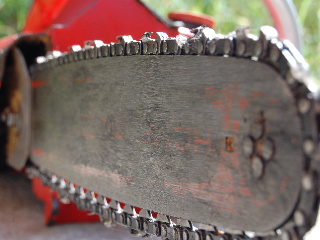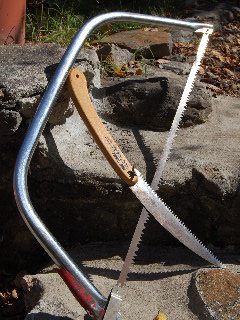
Hand pruning tools or power pruning tools—which do you need and when?
Gardening chores require a good assortment of basic hand tools that will be useful on a regular basis: shovels, rakes, trowels, spading forks, pitchforks, and cutting & pruning tools.
(Please watch our YouTube video
Pruning Tools For The Home Gardener for additional information and visual demonstrations of some of these tools.)
But when is it necessary to move from everyday hand tools to more specialized power tools--more specifically, when do you really need a chain saw? Won’t a pair of pruning shears or snips suffice? Or maybe just a small pruning saw? Let’s look at these garden maintenance devices, their intended applications, and examine the pros and cons of these cutting tools.
The bow saw is a multi-purpose, hand-held gardener’s friend from long ago. The “bow” frame, usually made of lightweight metal, holds a crosscut-tooth blade ranging in length from 12 inches to sometimes 36 inches or more. The size and strength of the bow saw makes it useful for cutting rather large tree limbs (up to 10 inches in diameter) from your trees, and also enables you to cut these large limbs into pieces to make them easier to handle for disposal or to create firewood-length pieces.
The drawback to the bow saw is that this is a labor-intensive device, and the bigger the stick you’re cutting, the more physically exhausting it becomes. Also, the bow frame itself, which extends up above the blade, often gets in the way of the cut you are trying to make, the frame blocked by or bumping into other tree limbs.
A smaller type of pruning saw, designed somewhat like a pocketknife with the blade swinging outward from the handle and then tightening into place with a wing nut, overcomes this problem of the bow frame bumping into tree limbs. This type of saw is very useful for removing small branches from within the tree and especially for making a clean cut close in to the main trunk. Its ease of use and maneuverability within the cutting areas are the pros; its small size enabling you to cut only the smaller branches being the con.

Pruning shears (like hedge-clippers) are useful only for cutting lightly wooded stemmed plants like yews, privets, and boxwoods. Shears of this type operate like scissors, cutting and shaping mostly foliage rather than heavily wooded stems.
Pruning snips are designed for cutting woody stems up to about ½ inch in diameter. Bigger sticks require a saw. The snips are either of the bypass design (scissor-like cut) or the anvil design (a sharp blade closes down on a flat fixed surface).
So, when do you need a chain saw? When you have a lot of branches to cut (as in a fairly large shade tree being blown over by the wind), or when you have large branches to cut up into smaller lengths (as in the case of this same blown-over shade tree!). But, how often do you think this situation will arise?! Certainly not very often, we hope.
So, here is my recommendation: use your hand tools (bow saws and pruning snips) for routine garden maintenance chores that involve pruning woody vegetation. And when the need for a chain saw arises, go rent one!
The rental chain saw will be properly adjusted, sharpened, and ready for use, and the rental place will give you the proper gas and oil for the saw. You eliminate the cost of purchasing a rather expensive tool that will only be used occasionally, and you won’t have to find a storage place for this tool until the next time you need it.
If you have a large tract of wooded land that you’re managing, maybe you need your own chain saw. But the average home gardener will save time and money on tool cost and maintenance by renting a good chain saw when one is needed!
 Hand pruning tools or power pruning tools—which do you need and when?
Hand pruning tools or power pruning tools—which do you need and when?
 Pruning shears (like hedge-clippers) are useful only for cutting lightly wooded stemmed plants like yews, privets, and boxwoods. Shears of this type operate like scissors, cutting and shaping mostly foliage rather than heavily wooded stems.
Pruning shears (like hedge-clippers) are useful only for cutting lightly wooded stemmed plants like yews, privets, and boxwoods. Shears of this type operate like scissors, cutting and shaping mostly foliage rather than heavily wooded stems.